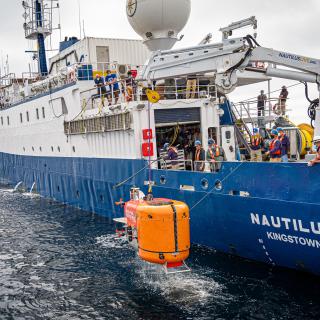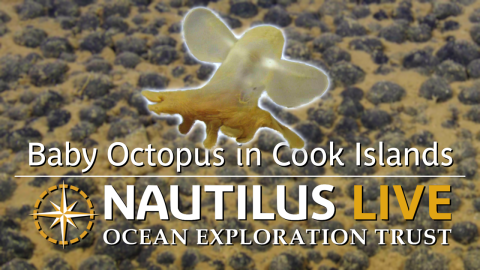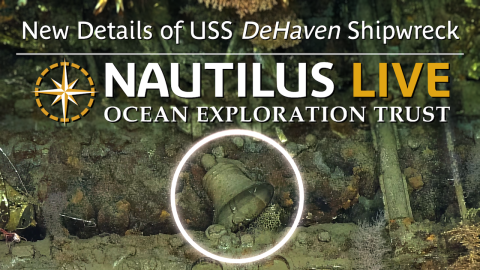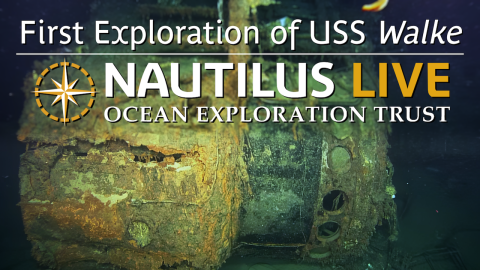Pushing the Edge of Deep-sea Exploration with HROV Nereid Under Ice (NUI)
As we continue to push the edge of underwater exploration, E/V Nautilus participated in testing a new wave of deep-sea technology and communication to advance our understanding of Earth’s oceans and the depth of their dynamic processes.
Funded by NOAA Ocean Exploration through the Ocean Exploration Cooperative Institute (OECI), one of the OECI’s goals is to build towards autonomous vehicles sharing information, allowing each vehicle to be more effective and to provide increased situational awareness to the vehicle operators aboard or ashore.
In September 2021, Nautilus hosted the hybrid remotely operated vehicle (HROV) Nereid Under Ice (NUI) off the coast of southern California to test acoustic modem communications between it and ROV Argus in what oceanographers have dubbed a momentous occasion in the advancement of deep-sea exploration.
NUI is a hybrid autonomous underwater vehicle (HROV) that was developed by engineers at the Woods Hole Oceanographic Institution (WHOI) as a vehicle originally intended to explore far under ice shelves and difficult-to-reach places. It can dive to depths of 2,000 meters to employ technological specifications such as an onboard navigation system, fiber-optic telecommunications, video and photo capability, a seven-function manipulator arm, as well as chemical and biological sensors.
But what sets NUI apart from other exploratory vehicles is its ability to operate in different modes, from fully autonomous (mapping on a preset mission) to semi-autonomous (receiving a new mapping mission mid-dive) — both settings that the team aboard Nautilus successfully demonstrated during this mission. The system is capable of conducting a wide variety of standard manipulation tasks typically done by conventionally tethered ROVs, but NUI is capable of operating at a much greater range from a host vessel.
A team of scientists both on ship and ashore deployed NUI to the seafloor with ROV Argus nearby for support. The two vehicles were able to “talk” to one another underwater using an optical modem that transmits information back to researchers. After a successful survey, NUI proved that it could generate maps that showed potential dive targets so that ROV pilots could focus on exploring areas of interest during that same dive rather than returning in subsequent explorations.
“It’s a really full house in the control room right now. The whole NUI team is here, working on a dive with the optical modem connected to Argus,” said Megan Cook, Ocean Exploration Trust (OET) Director of Education & Outreach, during a testing demonstration.
“What’s also exciting is there is a whole team ashore working on the troubleshooting as well, looking at how we can optimize and how we can improve the strength of the connection, which will let us do a little bit more of the autonomous manipulation, and the cool tests that are going on.”
During this technology testing, cameras aboard NUI and Argus offered a dual view of a gently sloping seafloor coated with bacterial mat, an area that proved ideal for operations testing of remote control of the manipulator arms aboard the AUV.
Despite its many successes, the mission was not without challenges over the course of six dive days. But troubleshooting and teamwork — along with a diverse array of electrical, mechanical, and scientific skill sets — proved that NUI has an important contribution to make in the future of telerobotics.
“We just reached another milestone in the development of advanced autonomous vehicle systems.,” said OET President Dr. Robert Ballard.“Then we’ve transferred control of the manipulator that you see functioning right now to people in Woods Hole with other people connected in Chicago, that are orchestrating a sampling routine with none of us operating it. This is now being completely operating with people off the ship and this is the portent of when we’re not even on the ship. We’re moving faster than I thought we were going to move. This has been quite a new milestone in our undersea exploration.”
This proof-of-concept operations test will lead to new methodologies or “concepts of operations” for underwater exploration in the future, including future OECI technology challenge missions on E/V Nautilus.

OECI Technology Demonstration: Nereid Under Ice (NUI) Vehicle + Mesobot
This expedition aboard E/V Nautilus will support the testing of novel or emerging capabilities with two different autonomous underwater vehicles from Woods Hole Oceanographic Institution (WHOI).



